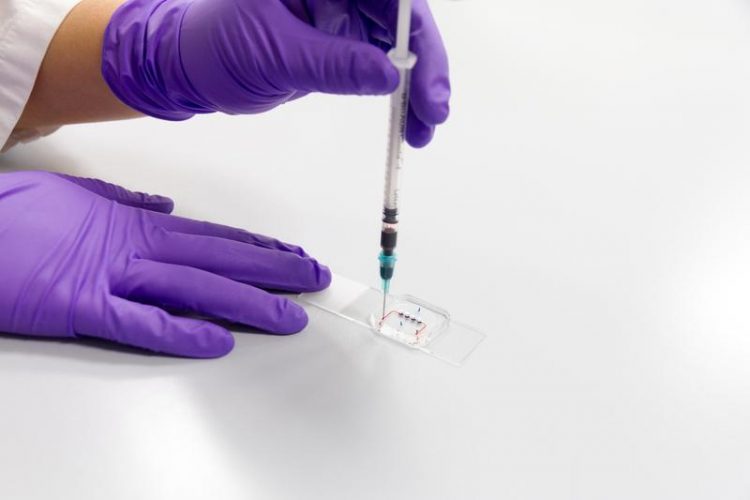Retina-on-a-chip provides powerful tool for studying eye disease

Organ-on-a-chip system. Fraunhofer IGB
The development of a retina-on-a-chip, which combines living human cells with an artificial tissue-like system, has been described today in the open-access journal eLife.
This cutting-edge tool may provide a useful alternative to existing models for studying eye disease and allow scientists to test the effects of drugs on the retina more efficiently.
Many diseases that cause blindness harm the retina, a thin layer of tissue at the back of the eye that helps collect light and relay visual information to the brain. The retina is also vulnerable to harmful side effects of drugs used to treat other diseases such as cancer.
Currently, scientists often rely on animals or retina organoids, tiny retina-like structures grown from human stem cells, to study eye diseases and drug side effects. But results from studies in both models often fail to describe disease and drug effects in people accurately. As a result, a team of scientists have tried to recreate a retina for testing purposes using engineering techniques.
“It is extremely challenging, if not almost impossible, to recapitulate the complex tissue architecture of the human retina solely using engineering approaches,” explains Christopher Probst, Postdoctoral Researcher at the Fraunhofer Institute for Interfacial Engineering and Biotechnology in Stuttgart, Germany, and co-lead author of the current study.
To overcome these challenges, the scientists coaxed human pluripotent stem cells to develop into several different types of retina cells on artificial tissue. This tissue recreates the environment that cells would experience in the body and delivers nutrients and drugs to the cells through a system that mimics human blood vessels.
“This combination of approaches enabled us to successfully create a complex multi-layer structure that includes all cell types and layers present in retinal organoids, connected to a retinal pigment epithelium layer,” says co-lead author Kevin Achberger, Postdoctoral Researcher at the Department of Neuroanatomy & Developmental Biology at the Eberhard Karls University of Tübingen, Germany. “It is the first demonstration of a 3D retinal model that recreates many of the structural characteristics of the human retina and behaves in a similar way.”
The team treated their retina-on-the-chip with the anti-malaria drug chloroquine and the antibiotic gentamicin, which are toxic to the retina. They found that the drugs had a toxic effect on the retinal cells in the model, suggesting that it could be a useful tool for testing for harmful drug effects.
“One advantage of this tiny model is that it could be used as part of an automated system to test hundreds of drugs for harmful effects on the retina very quickly,” Achberger says. “Also, it may enable scientists to take stem cells from a specific patient and study both the disease and potential treatments in that individual’s own cells.”
“This new approach combines two promising technologies – organoids and organ-on-a-chip – and has the potential to revolutionise drug development and usher in a new era of personalised medicine,” concludes senior author Peter Loskill, Assistant Professor for Experimental Regenerative Medicine at the Eberhard Karls University of Tübingen, and head of the Fraunhofer Attract group Organ-on-a-Chip at the Fraunhofer Institute for Interfacial Engineering and Biotechnology. His laboratory, which spans the two institutes, is already developing similar organ-on-a-chip technology for the heart, fat, pancreas and more.
Reference
The paper ‘Merging organoid and organ-on-a-chip technology to generate complex multi-layer tissue models in a human Retina-on-a-Chip platform’ can be freely accessed online at https://doi.org/10.7554/eLife.46188. Contents, including text, figures and data, are free to reuse under a CC BY 4.0 license.
Fraunhofer Research News 9/2019
You can also find out more about this topic in the upcoming issue of the Fraunhofer publication “Research News”, which will be published on September 2, 2019.
https://doi.org/10.7554/eLife.46188
https://www.igb.fraunhofer.de/en/press-media/press-releases/2019/retina-on-a-chi…
Media Contact
All latest news from the category: Medical Engineering
The development of medical equipment, products and technical procedures is characterized by high research and development costs in a variety of fields related to the study of human medicine.
innovations-report provides informative and stimulating reports and articles on topics ranging from imaging processes, cell and tissue techniques, optical techniques, implants, orthopedic aids, clinical and medical office equipment, dialysis systems and x-ray/radiation monitoring devices to endoscopy, ultrasound, surgical techniques, and dental materials.
Newest articles

Retinoblastoma: Eye-Catching Investigation into Retinal Tumor Cells
A research team from the Medical Faculty of the University of Duisburg-Essen and the University Hospital Essen has developed a new cell culture model that can be used to better…

A Job Well Done: How Hiroshima’s Groundwater Strategy Helped Manage Floods
Groundwater and multilevel cooperation in recovery efforts mitigated water crisis after flooding. Converting Disasters into Opportunities Society is often vulnerable to disasters, but how humans manage during and after can…

Shaping the Future: DNA Nanorobots That Can Modify Synthetic Cells
Scientists at the University of Stuttgart have succeeded in controlling the structure and function of biological membranes with the help of “DNA origami”. The system they developed may facilitate the…



